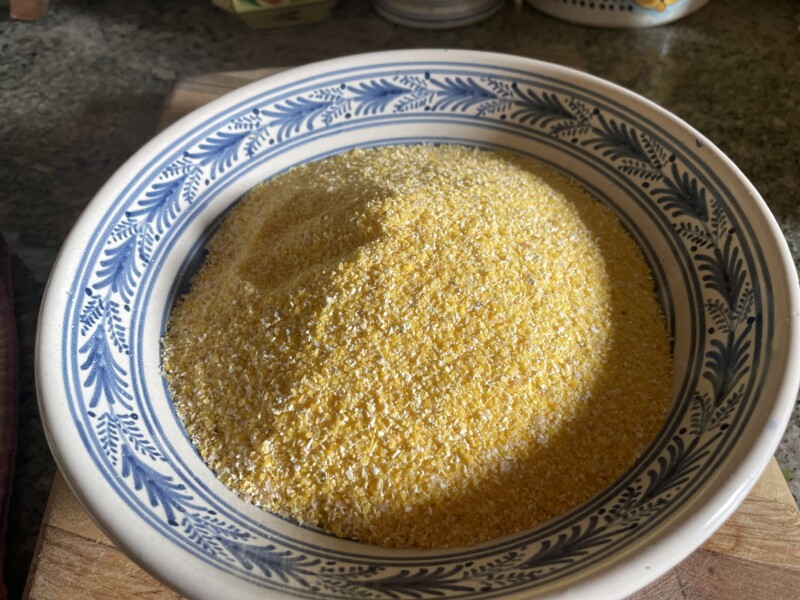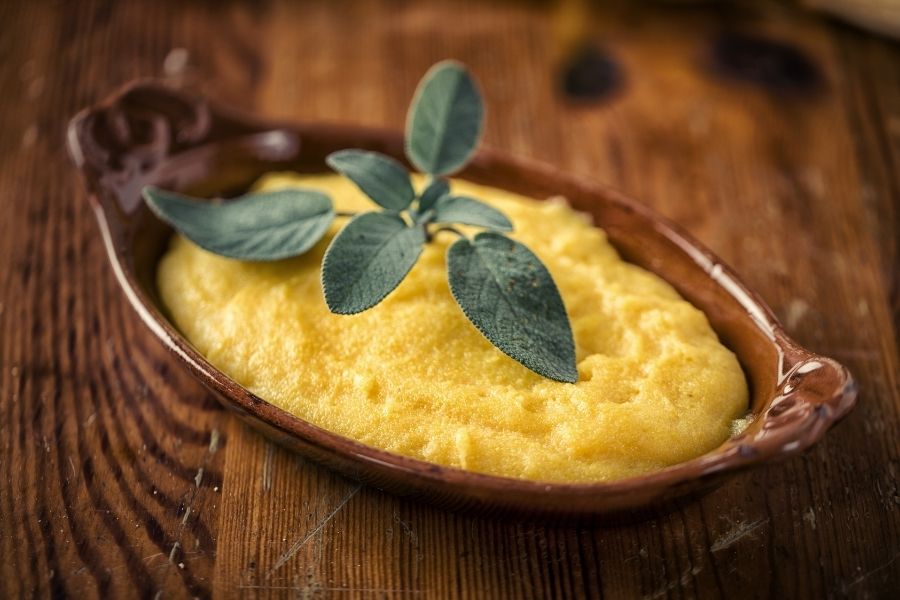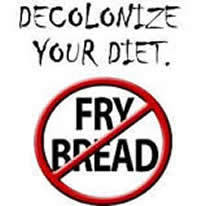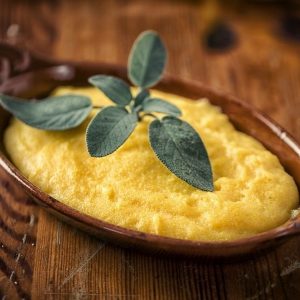Exclusive! I’m excited to share this sofkee recipe from Miami Vegan, perfect for Indigenous Peoples’ Day.
Celebrate Indigenous Peoples’ Day by enjoying corn, one of the Magic Eight crops Indigenous Americans gifted to the world. The wonderful thing is that fresh corn, for all its juiciness, dries beautifully, then lasts indefinitely. Then it can be ground, so there is always, always, always cornmeal and grits.

Maybe you call it grits. Maybe you call it polenta. Maybe you call it mamaliga. For many indigenous tribes, including Florida’s Seminole and Miccosukee, it’s sofkee, and they should get dibs on the name. They were growing, drying and grinding corn (aka maize) millennia before Columbus even got here.
Jump to the recipe or stick around for more of the sofkee storyHow to Make (without Mess)
- Preheat oven to 350 degrees.
- Generously oil a deep ovenproof casserole. Pour in cornmeal and water, add a good pinch of sea salt. You’ll want more when it’s done. Give everything a stir, so it forms a slurry. It will not look pretty. Have heart.
- Place casserole in the oven uncovered and leave it to work its sofkee sorcery for 1 hour.
- Remove from oven and give it a vigorous stir so everything’s smooth and lumpless,
- Season generously with sea salt and fresh ground pepper and more olive oil or vegan butter, if desired.

Tips
- The thing we often forget — corn is a whole grain.
- Whenever possible, choose organic grits, like Bob’s Red Mill, Arrowhead Mills. The majority of the corn grown in America is genetically modified. That’s not what I want for you. Go for organic. You owe it to yourself and the planet.
- Grits and cornmeal are both corn, but cornmeal is ground finer. Fabulous for cornbread, it makes less successful sofkee. Choose packages that say polenta or grits.
- Hominy is something else entirely. Confused? Don’t be. Like cornmeal and grits, it’s made from dried corn. Hominy is dried corn that’s been nixtamilized, or soaked in lye or lime to strip its tough outer hull. The result is plump, pillowy kernels that will further plump in cooking and taste like the essence of toasted corn tortilla.
- Yellow grits or white grits? I used to think the yellow were less processed, and that’s what I prefer. Turns out yellow grits and white grits are almost equal in terms of nutrition and culinary performance. The difference is the variety of corn. I still have a preference for yellow grits, but maybe it’s just the golden color.
Traditionally, making this pot of creamy comfort involves dried ground corn, a lot of water or broth, and a whole lot of time stirring and standing over the fire or stove. Turn the heat up too high and you get splattered. Turn it down too low and it feels like cooking takes forever till the grits and water come together to create something greater than the sum of its parts.
My culinary mentor Paula Wolfert has shared a genius hack to make flawless sofkee every time. There’s no standing and stirring no splatters on your stovetop or you. It’s baked! Ugly when it goes in, still not Insta-pretty when it comes out, but give it a stir, add sea salt, pepper and vegan butter, and you’ve got a pot of wow.
Sofkee has a million applications. It can be creamy, it can be firm, it can be chilled, then sliced and roasted or fried so the slices or slas become crispy cakes.
Corn is one of the Magic Eight, the crops grown by the Indigenous People beloved by the whole world. The other seven members are:
- tomatoes
- potatoes
- chiles
- squash
- beans
- cacao
- vanilla
A simple, comforting dish, sofkee is swathed in elaborate ritual. Corn itself is sacred to the Indigenous People and a symbol of fertility. Florida’s Miccosukee tribe traditionally served a communal pot of sofkee at gatherings. Guests were served first, each ladling up the porridge with a large spoon carved from pond apple, a South Florida hardwood. One by one, each person would eat their fill, then passed the spoon to the next person to dip and sip.

Every culture and cuisine loves corn and cornmeal mush, but the world would never know it but for the Indigenous People, for whom it was both sacred food and and sustenance. So bring a little reverence to the table the next time you make it.
For more about sofkee/polenta/mamaliga, check out my article in Whetstone. Sofkee has a million riffs, and almost as many names, but it’s always a pot of comfort and goodness that serves everyone.
RECIPE

Sofkee
Ingredients
- 2 tablespoons olive oil plus more for finishing.
- 1 cup medium to coarse cornmeal
- 4-5 cups water 4 if you want a firmer, more solid sofkee, 5 if you want it looser and creamier
- sea salt and ground pepper — be generous
Instructions
- Preheat oven to 350 degrees.
- Generously oil a deep ovenproof casserole. Pour in cornmeal and water, add a good pinch of sea salt. You’ll want more when it’s done. Give everything a stir, so it forms a slurry. It will not look pretty. Have heart.
- Place casserole in the oven uncovered and leave it to work its sofkee sorcery for 1 hour.
- Remove from oven and give it a vigorous stir so everything’s smooth and lumpless,
- Season generously with sea salt and fresh ground pepper and more olive oil if desired.
Notes
- Make it richer with a pat or two of vegan butter or drizzle on some cashew cream
- Make it cheesier by adding nutritional yeast and/or grated vegan cheese
- Add a fistful of your favorite herbs, chopped tomato and/or chopped jalapeno
- Let it serve as a yummy bed for grilled or roasted vegetables
- Pair with Sukuma Wiki, Cuban black beans or mushroom etouffée.
- Splash with hot sauce
- Enjoy the sweeter side of sofkee — top with fresh fruit, cinnamon, chopped nuts, a drizzle of cashew cream and/or maple syrup or molasses
More Fun with Corn
- Hominy beans and green chili stew
- maque choux
- grilled vegetables with grits cakes
- Sweet Potato Soul’s coconut corn chowder
- Eddie Garza’s Mexican chocolate dessert tamales

Leave a Reply